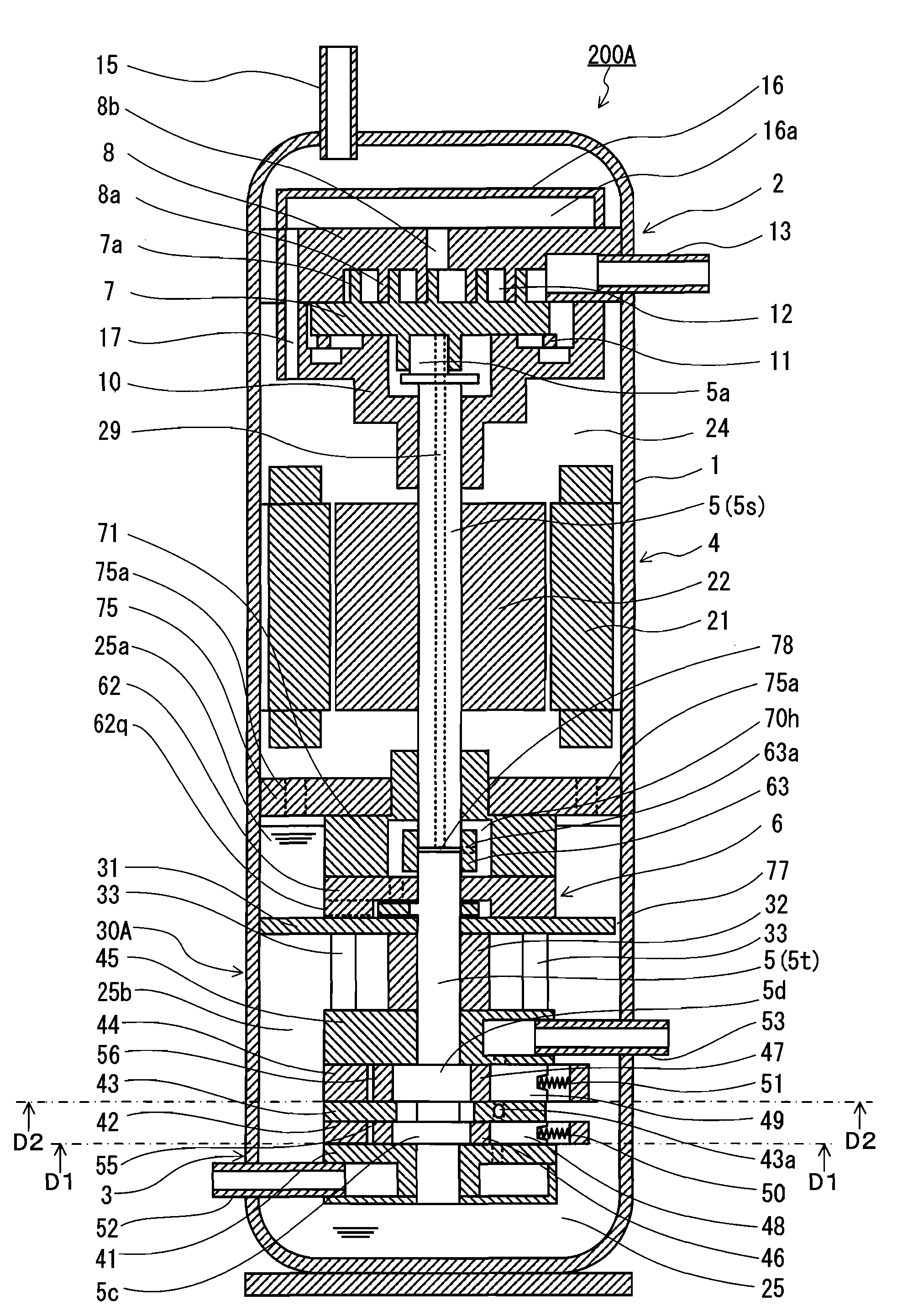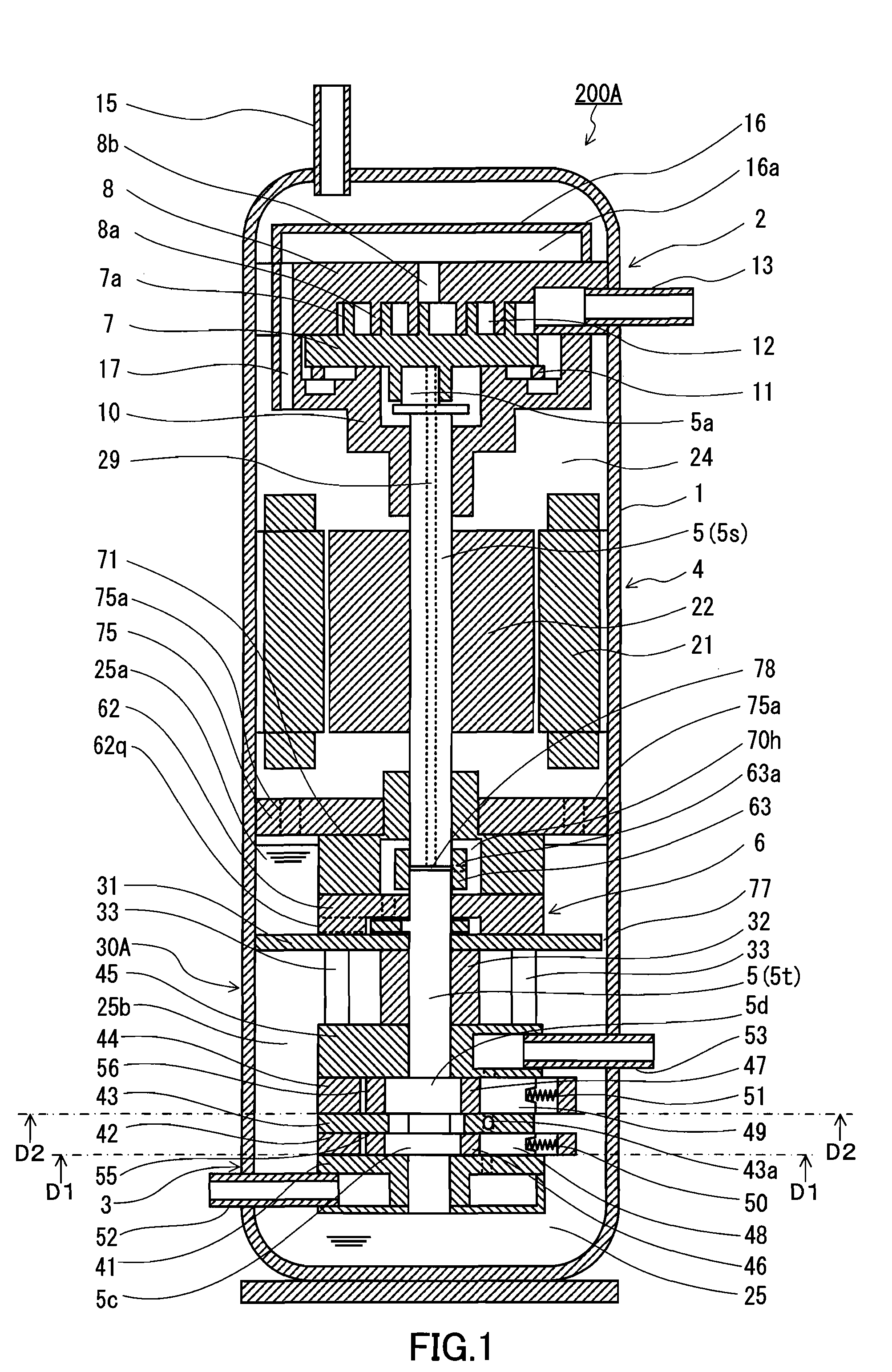Expander-integrated compressor
a compressor and expander technology, applied in the direction of positive displacement liquid engines, liquid fuel engines, piston pumps, etc., can solve the problems of affecting the performance coefficient of the system using the expander-integrated compressor, raising the temperature, etc., to suppress heat transfer, suppress oil, and high temperature during operation
- Summary
- Abstract
- Description
- Claims
- Application Information
AI Technical Summary
Benefits of technology
Problems solved by technology
Method used
Image
Examples
modified example 1
[0081]First, the locations of the oil pump 6 and the coupling portion of the shaft 5 are interchangeable vertically. In the modified example shown in FIG. 6, the oil pump 6 is disposed above the coupling portion of the shaft 5, and the relay member 171 is disposed adjacent to a lower face of the oil pump 6. The piston 61 of the oil pump 6 is fitted into an eccentric portion of the first shaft 5s. Such a positional relationship allows the high temperature oil to be drawn into the oil pump 6 more quickly, enhancing the effect of suppressing the heat transfer. This effect also can be achieved in the examples shown in FIG. 11, FIG. 12, and FIG. 13.
[0082]In Modified Examples 2 to 7 described below, an inlet 29p of the oil supply passage 29 is formed in an outer circumferential surface of the shaft 5, away from the coupling portion of the shaft 5. With such a configuration, the inlet 29p of the oil supply passage 29 is closer to a rotation axis of the shaft 5 than in the examples shown in...
modified example 2
[0085]In the modified example shown in FIG. 7, the oil supply passage 29 is formed only in the first shaft 5s. The inlet 29p of the oil supply passage 29 is formed in the outer circumferential surface of the first shaft 5s, at a position slightly higher than a lower end portion of the first shaft 5s fitted into the coupler 63. The inlet 29p faces the internal space 70h of the relay member 71. As described earlier with reference to FIG. 3, the internal space 70h of the relay member 71 is connected to the working chamber of the oil pump 6 via the oil discharge passage 62b, and is filled with the oil discharged from the oil pump 6. That is, the internal space 70h of the relay member 71 constitutes the relay passage that guides to the oil supply passage 29 the oil discharged from the oil pump 6. The relay passage connects the oil pump 6 to the oil supply passage 29. The internal space 70h of the relay member 71 includes the cylindrical space surrounding the first shaft 5s in the circumf...
modified example 3
[0088]In the modified example shown in FIG. 8, the oil supply passage 29 is formed through the first shaft 5s and the second shaft 5t. The coupling portion of the shaft 5, the inlet 29p of the oil supply passage 29, and the oil pump 6 (specifically, the portion in which the working chamber is formed) are arranged in this order from the compression mechanism 2 side. Such an arrangement in which the oil pump 6 is located below the coupling portion of the shaft 5 makes assembling work of the expander-integrated compressor easier than an arrangement in which they are located in reverse order.
[0089]The assembling work of the expander-integrated compressor starts with fixing the compression mechanism 2, the motor 4, and the support frame 75 to a body portion of the closed casing 1 in order. The expansion mechanism 3 is assembled outside the closed casing 1, and eventually is accommodated in the closed casing 1 in such a manner that the expansion mechanism 3 is integrated with the compress...
PUM
 Login to View More
Login to View More Abstract
Description
Claims
Application Information
 Login to View More
Login to View More - R&D
- Intellectual Property
- Life Sciences
- Materials
- Tech Scout
- Unparalleled Data Quality
- Higher Quality Content
- 60% Fewer Hallucinations
Browse by: Latest US Patents, China's latest patents, Technical Efficacy Thesaurus, Application Domain, Technology Topic, Popular Technical Reports.
© 2025 PatSnap. All rights reserved.Legal|Privacy policy|Modern Slavery Act Transparency Statement|Sitemap|About US| Contact US: help@patsnap.com



